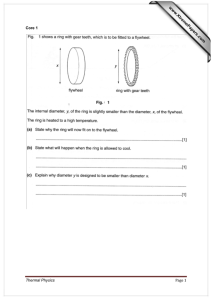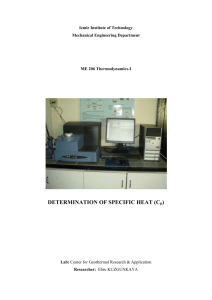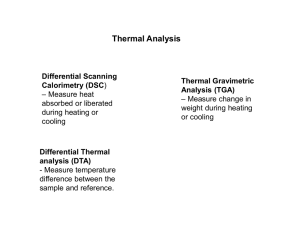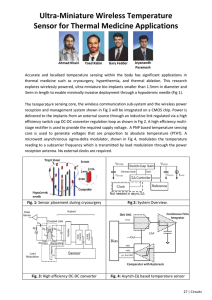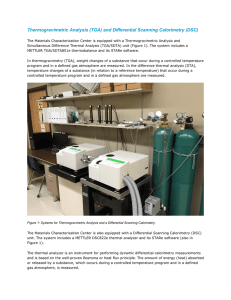Computer applications in thermal analysis Brian Sisk , Wei-Ping Pan , Alan Riga
advertisement
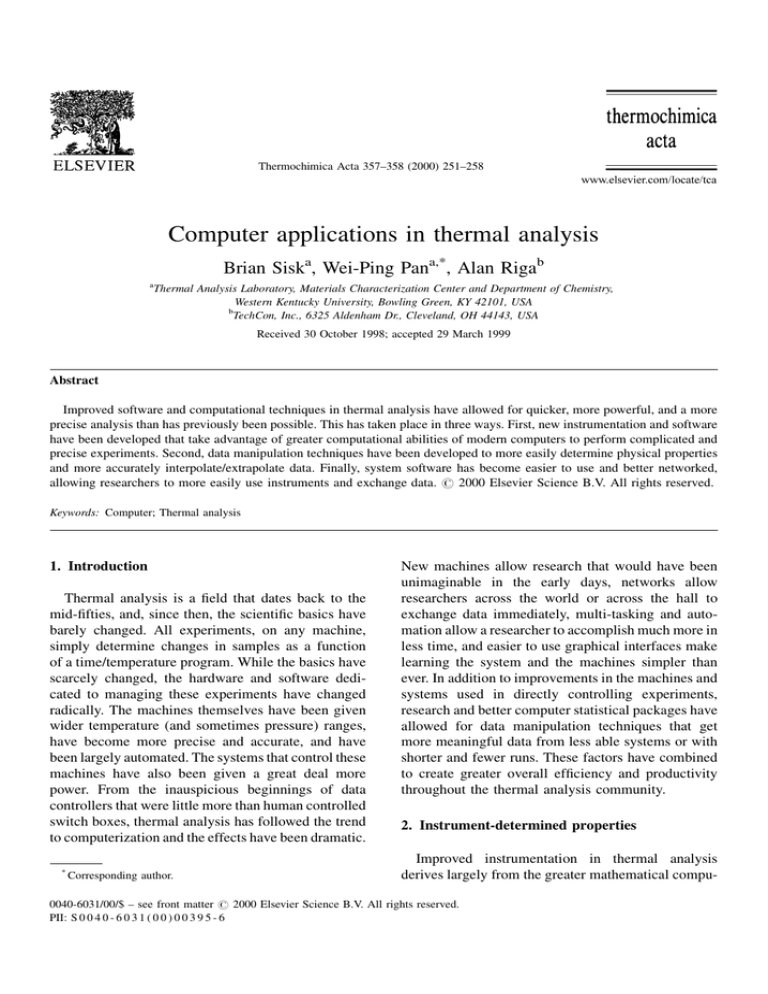
Thermochimica Acta 357±358 (2000) 251±258 Computer applications in thermal analysis Brian Siska, Wei-Ping Pana,*, Alan Rigab a Thermal Analysis Laboratory, Materials Characterization Center and Department of Chemistry, Western Kentucky University, Bowling Green, KY 42101, USA b TechCon, Inc., 6325 Aldenham Dr., Cleveland, OH 44143, USA Received 30 October 1998; accepted 29 March 1999 Abstract Improved software and computational techniques in thermal analysis have allowed for quicker, more powerful, and a more precise analysis than has previously been possible. This has taken place in three ways. First, new instrumentation and software have been developed that take advantage of greater computational abilities of modern computers to perform complicated and precise experiments. Second, data manipulation techniques have been developed to more easily determine physical properties and more accurately interpolate/extrapolate data. Finally, system software has become easier to use and better networked, allowing researchers to more easily use instruments and exchange data. # 2000 Elsevier Science B.V. All rights reserved. Keywords: Computer; Thermal analysis 1. Introduction Thermal analysis is a ®eld that dates back to the mid-®fties, and, since then, the scienti®c basics have barely changed. All experiments, on any machine, simply determine changes in samples as a function of a time/temperature program. While the basics have scarcely changed, the hardware and software dedicated to managing these experiments have changed radically. The machines themselves have been given wider temperature (and sometimes pressure) ranges, have become more precise and accurate, and have been largely automated. The systems that control these machines have also been given a great deal more power. From the inauspicious beginnings of data controllers that were little more than human controlled switch boxes, thermal analysis has followed the trend to computerization and the effects have been dramatic. * Corresponding author. New machines allow research that would have been unimaginable in the early days, networks allow researchers across the world or across the hall to exchange data immediately, multi-tasking and automation allow a researcher to accomplish much more in less time, and easier to use graphical interfaces make learning the system and the machines simpler than ever. In addition to improvements in the machines and systems used in directly controlling experiments, research and better computer statistical packages have allowed for data manipulation techniques that get more meaningful data from less able systems or with shorter and fewer runs. These factors have combined to create greater overall ef®ciency and productivity throughout the thermal analysis community. 2. Instrument-determined properties Improved instrumentation in thermal analysis derives largely from the greater mathematical compu- 0040-6031/00/$ ± see front matter # 2000 Elsevier Science B.V. All rights reserved. PII: S 0 0 4 0 - 6 0 3 1 ( 0 0 ) 0 0 3 9 5 - 6 252 B. Sisk et al. / Thermochimica Acta 357±358 (2000) 251±258 Fig. 1. TM-DSC plot of a polymer sample. tational abilities of modern computers. This has spawned a new generation of instruments that can perform a wider range of tasks and perform established research with greater precision. Examples of such instruments are TM-DSC, DMA, TMA, and DRTGA. TM-DSC differs from regular DSC due to its sinusoidally modulated temperature program, imposed on a standard linear temperature program [1]. Both, the frequency and the amplitude of modulation as well as the linear heating rate can be adjusted. The result is that the TM-DSC, unlike its predecessor, is able to separate more complex transitions into more easily interpreted components, and to increase sensitivity in order to detect weaker transitions and melts. In addition, heat capacity and heat ¯ow can be directly measured in a single experiment (Fig. 1). These properties can be determined due to the TM-DSCs ability to separate reversible from non-reversible heat ¯ows. Speci®c heats are determined from the reversible heat-¯ow curve, while kinetic transitions are manifested in the non-reversible heat ¯ow. DMA and rheology have also bene®ted greatly from the computerization that has taken place. First, modern DMA systems are now incredibly precise, largely owing to computational developments within the machines. In addition, software can now perform certain functions that were formerly done through complicated statistical procedures. An example of this is the time±temperature superposition (TTS). The need for this analysis arose due to the viscoelastic nature of polymeric materials, which exhibit behavior during deformation that is both, time- and temperature-dependent. This would present a problem for the rheologist, because the range of frequencies allowed by an instrument might be insuf®cient for such analysis, and, even if it were suf®cient, would result in long, complicated experiments. TTS allows limited test data at shorter times to be extrapolated to longer term conditions for samples that obey time±temperature properties. Figs. 2±4 show TTS results for a polyimide. Fig. 2 shows the DMA multi-frequency curves obtained over a range of four decades (0.1±100 Hz). Fig. 3 shows the master curve B. Sisk et al. / Thermochimica Acta 357±358 (2000) 251±258 Fig. 2. DMA temperature multiplex plot. Fig. 3. TTS master curve. 253 254 B. Sisk et al. / Thermochimica Acta 357±358 (2000) 251±258 Fig. 4. TIS plot of shift factor vs. temperature. obtained by combining the multi-frequency experiments. This is done by plotting the data on the same axes, re-scaling the individual curves if desired, and then shifting them so they overlap a given reference curve. A best ®t is then applied to the data, and this becomes the master curve. Fig. 4 represents the ®t of shift factor vs. temperature to the William±Landel± Ferry (WLF) equation. The shift factor for a given curve is the amount that curve must be shifted to overlap the reference curve, with the x-axis being log (frequency). Although the WLF ®t is, in this case, inaccurate at lower temperatures, the data can be made more accurate at lower temperatures in order to achieve data for the high-frequency ranges. In this way, the frequency range of viscoelastic properties can be estimated beyond what the instrument can actually accomplish. Computer techniques for the determination of TMA properties, such as coef®cient of thermal expansion, also exist. There are two principal methods for this, depending on the nature of the material. For materials essentially exhibiting linear expansion characteristics, the point-to-point method can be used, such as in Fig. 5. However, for materials that have a non-linear coef®cient, the data must be ®tted to a straight line, as in Fig. 6. The software will produce an average expansion value for the temperature range. Separation of decompositions that occur at nearly the same temperature has long been a problem with TGA. Traditionally, a lower heating rate was the most common way of separating these peaks. This, however, resulted in runs that could be many hours long, sometimes monopolizing the instrument for an entire working day. This problem can be somewhat alleviated by the dynamic rate TGA, or DRTGA software [2]. This controller software, usually compatible with existing systems and instruments, allows the heating rate to be adjusted (usually lowered) based on the %/min decomposition rate. The principle behind DRTGA is that the heating rate can be lowered when needed to separate decompositions, but when the decomposition is ®nished, the heating rate will increase again, allowing for signi®cant time savings. The user can enter minimum and maximum heating rates, as well as a threshold which determines how much of a %/min weight loss is needed to cause the heating rate to be affected, and by how much. In addition to the above method of resolving decompositions, DRTGA can also maintain a constant Fig. 5. TMA plot of a polymer with roughly linear coef®cient of thermal expansion. Fig. 6. TMA plot of a polymer with non-linear coef®cient of thermal expansion. 256 B. Sisk et al. / Thermochimica Acta 357±358 (2000) 251±258 reaction rate. It does this by reducing the heating rate or even cooling the sample to maintain a reaction rate in terms of %/min weight loss. This allows reactions to proceed at highly controlled conditions. This can be particularly important for samples that are volatile, or substances, such as explosives or pyrotechnics, that need to have their reaction rates maintained at a particular level. 3. Properties determined through data manipulation In addition to the greater capabilities that instruments and analysis software have provided, statistical software has also given the researcher the ability to determine properties that cannot be found through direct analysis, or that are more dif®cult directly. Flynn±Wall decomposition kinetics procedures allow the activation energy and pre-exponential factor for a reaction in a TGA experiment [3]. This is done by performing a series of TGA runs, varying only the heating rate. Some quite complicated mathematics follows, but a decent statistics package or kinetics software can easily perform the calculations. Fig. 7 shows the TGA decomposition curves for a polyimide subjected to several heating rates. Using kinetic software, the activation energy as well as the pre-exponential were found. A similar method was developed for DSC by Borchardt and Daniels (BD) [4]. In this way, a DSC can be used to determine reaction kinetics in addition to temperature and heats of reaction. Many kinetics programs exist for analysis of the DSC data. These programs have various applications, such as modeling of curing and thermal hazard analysis during manufacturing and storage. In addition to pre-exponential factor, energy of activation, and enthalpy, these DSC kinetics programs can determine rate constant and reaction order as well. Fig. 8 shows the kinetic parameters for the cure process of a polyimide obtained by the BD program. These properties are determined from a single DSC run, by acquiring a set of 20 evenly spaced data points corresponding to temperature, heat ¯ow at a point, and enthalpy over a small interval. A multiple linear regression is then performed on the data, allowing the properties above to be determined. The formula for this regression is: Fig. 7. TGA plot of four runs at different heating rates for Flynn±Wall kinetics. B. Sisk et al. / Thermochimica Acta 357±358 (2000) 251±258 257 Fig. 8. DMA curve used for Borchardt±Daniels kinetics. dH ln dt 1 DH0 ln Z ÿ E RT DHT nln 1 ÿ DH0 Here, Z is the exponential factor, E the activation energy, and n the reaction order. In addition to determining properties, this software can be used to smooth data for the purposes of interpolation or the resolution of peaks that are somewhat lost in noise. This allows better data to be acquired in situations where the signal-to-noise ratio is somewhat less than desirable. There are many methods for doing this. Two of them are the Lagrange polynomial interpolation method and the movingaverages method. A variation of the Lagrange model is employed so as to make it usable in spreadsheet and statistics [5] programs. The formula is f xi 4 f xiÿ1 f xi1 ÿ f xiÿ2 f xi2 6 The theory behind this formula is that, for any given point xi, the points before and after xi are added together, as are those two points away from xi. The ®rst sum is given a weight of 4, and the second sum is subtracted. As a result, we have the sum of 6 terms (42ÿ2), hence the resultant sum is divided by 6. This version uses a value of 3 for n, meaning that the points within two points of xi are used in the analysis. A higher n value would mean that more points on either side of xi would be used in the analysis. Another smoothing formula, moving averages, can also be used. Probably, the simplest smoothing technique, it simply involves adding the values of f(xi) between xi and xin, dividing by n, and assigning the result to xi on the smoothed curve. With moving averages, however, the curve has not only been smoothed but shifted. This is due to the fact that the values being added are all for values of x>xi. This can be alleviated by using values on either side of xi in the moving average. This would make it similar to the Lagrange method, only without the weighting values (while Lagrange uses a value of 4 for the x value, one 258 B. Sisk et al. / Thermochimica Acta 357±358 (2000) 251±258 position from xi and a value of ÿ1 for the x value two positions from xi, moving averages uses no weights, treating them all equally). 4. A better system and controller software In addition to greater instrumental performance and computational ability, modern computers have afforded a better platform on which to run more powerful and easier to use thermal analysis system software. The improvements have come mainly in three areas: networking, multi-tasking, and ease of use. Networking is of great use to any researcher. Using a networked system, users can share data with colleagues and clients wherever they might be. This allows researchers to work away from the lab, or to get new data anywhere. In addition, it allows more people to work at once, because more people can access the data. This results in greater productivity. Multi-tasking allows one controller to simultaneously run many instruments. This is extremely useful for mid-size labs that need a variety of instrumentation, but not a controller for each one. Formerly, it was possible to connect more than one instrument to a controller, but only one instrument could be used at a time. Now, it is possible to run up to eight instruments at once if necessary [6]. This clearly allows researchers to accomplish more with less time by allowing multiple experiments to be run simultaneously. Many of the modern systems, such as TA's thermal solutions 5200 and Perkin±Elmer's Pyris, can accomplish this. Modern thermal analysis systems are much easier to use than their older counterparts. While older systems required typed commands and some ran on obscure proprietary operating systems, modern systems run on Windows (NT usually), which is known to virtually everyone. Also, newer systems are all graphically oriented rather than command-oriented, making the software easier to learn. This allows users new to the system to become productive quicker, rather than learning commands. In addition, some systems, such as Perkin±Elmer's Pyris software, come with multimedia help in which the user can actually watch a video that teaches various techniques in thermal analysis. These features have made thermal analysis systems much easier to use. 5. Conclusions While many advancements have been made in computer technology, to a large degree it is not being taken advantage of. Software and computer systems are not being updated because of cost, and complicated algorithms and computational techniques are not being used because they can be dif®cult and timeconsuming. However, it is almost universally true for a moderate-sized lab that the cost expenditure involved in procuring modern system software is returned many times over in terms of productivity gained. In addition, computerized data manipulation techniques can quickly reveal much that would otherwise require better instrumentation or more time. Utilizing better software and data manipulation techniques can allow any lab to accomplish more with less time and resources. References [1] TA Instruments, Modulated DSCTM, TA, New Castle, DE, pp. 1±4. [2] I. Groves, et al., Differentiation between Grades of ABS by Hi-Res TGA, TA, Leatherhead, UK, pp. 1±3. [3] TA Instruments, TGA Decomposition Kinetics Data Analysis Program Manual, TA, New Castle, DE, 1993, pp. 67±69. [4] TA Instruments, DSC Borchardt±Daniels Kinetics Data Analysis Program Operator's Manual, TA, New Castle, DE, 1993, pp. 53±70. [5] G. Varhegyi, F. Till, Computer Processing of Thermogravimetric±mass spectrometric and high-pressure thermogravimetric data Part 1. Smoothing and Differentiation, Hungarian Academy of Sciences, Budapest, p. 4. [6] The Perkin±Elmer Corporation, Pyris Software for Windows, Perkin±Elmer, Norwalk, CT, 1996, p. 5.
